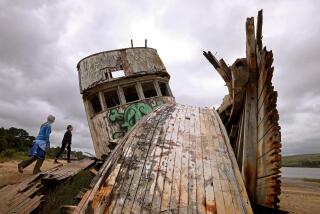Rugged Steam Schooners Part of County History
On my almost daily walks in late afternoons around Balboa Island to keep myself in the best condition, considering my condition, as possible, my heart never fails to leap happily at the sight of the old Balboa Pavilion across Newport Bay.
Eventideâs deepening shadows accentuate the friendly recesses beneath the pavilionâs broad eaves. Its proud cupola reaches into the sunset-tinged sky, where, at this time of year, flocks of gulls circle, preparing, Iâm told, to wing to Catalina Island for the night.
The pavilion was built in 1905, when the final flights of sails moved over the sea like birds, and a few small schooners managed to bump unscathed over the treacherous sand bar that was the bane of mariners attempting to enter Newport Bay. The long, twin rock jetties, making a safe entrance, were not built until 1936.
One local historian claimed the wood used to build the Pavilion was brought by barge over the sand bar. A few others skip lightly over the matter. And here lies a mystery Iâve pondered, until just the other day when I talked with the pavilionâs current owner, Phil Tozer.
Tozer solved the mystery neatly. Steam schooners brought it to McFaddensâ Wharf, he said; they brought fir for the pavilionâs basic structure and redwood for its siding. And that was that. It made sense.
In 1888, James and Robert McFadden, leaders in the shipping business along the Orange County coast, built a large, deep-water, ocean wharf on the site of todayâs Newport Beach Municipal Pier on the Balboa Peninsula. Here came, among larger deep-water ships, the doughty little steam schooners carrying lumber from Northern California. It was only a short haul, about a thousand yards across the sandy peninsula, to cart the fir and redwood from the wharf to the pavilionâs building site.
Purists may scoff at the term steam schooner, but Tozer used it and knew what it represented. âSteam schoonerâ is rooted in the language of the West Coast. It was a unique working craft, designed to ship lumber, especially California redwood, from the bays and bights, or âdog holes,â as they were called, of Mendocino.
Seafaring humor declared that only a dog had room enough to turn around in these rockbound indentations in that wild coastline where thousands of acres of giant redwoods towered skyward. It was impossible to navigate conventional lumber schooners in these dog holes. The steam schooners were loaded with lumber by using wooden slides or wire cables from the tops of cliffs. Dozens of sawmills dotted this rugged terrain.
Steam schooners were bluff-bowed, beamy, shoal of draft, schooner-rigged with fore and aft sails, and engine and boiler below. As one old-time skipper may have remarked, âA vessel with a fair wind in the stoke-hold can go just about when and where she pleases.â And go they did, sailing and steaming reliably up and down the coast, from San Diego and north beyond San Francisco.
Iâm sure better local historians than I can furnish some idea of the amount of lumber these little ships, as well as larger, conventional lumber schooners from deep-water lumber ports, brought to McFaddensâ Wharf. The pavilion is only one of perhaps a thousand or more early commercial buildings and homes built in Orange County with California redwood and fir. Maybe Jim Sleeper has a shrewd estimate or Bill Hendricks or Ellen Lee? Iâm certain Santa Ana and Tustin still have buildings standing, the materials of which made a sea voyage here on the decks and holds of these wonderful little steam schooners.
More to Read
Sign up for The Wild
Weâll help you find the best places to hike, bike and run, as well as the perfect silent spots for meditation and yoga.
You may occasionally receive promotional content from the Los Angeles Times.






